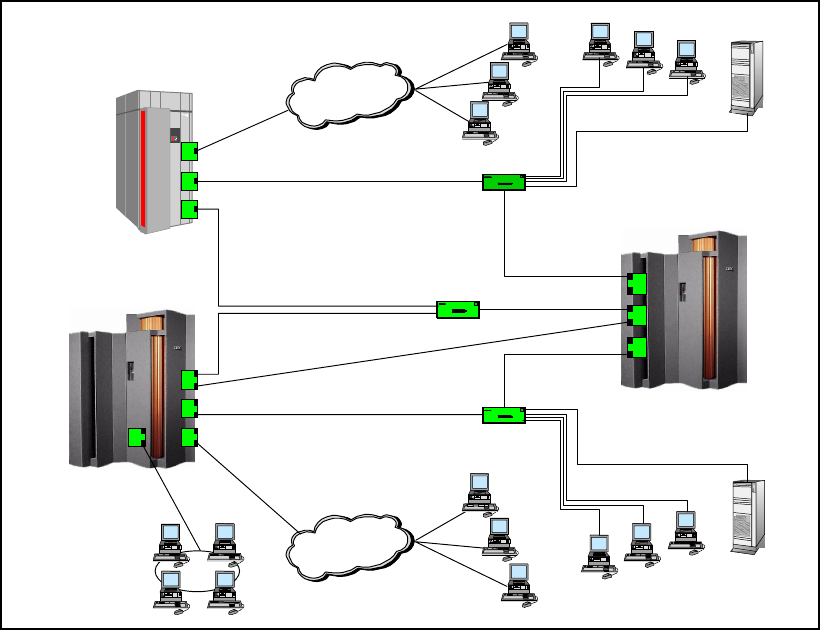Chapter 3. Connectivity 131
Although there is only one FDDI port, there are two connectors available for either single-ring
or dual-ring environments. The connector labelled FA is the primary connector, and the
connector labelled FB is the secondary connector.
The OSA-2 FDDI adapter is designed with a dual-ring topology in mind. This is made up of
the two connectors on the card: FA and FB. The FA connector is made up of the Primary In
(Receiver) and Secondary Out (Transmitter), and the FB connector is made up of the Primary
Out (Transmitter) and the Secondary In (Receiver). When you connect an A connector to a B
connector, you make a complete ring.
For further information, see the following manuals:
Planning for the Open Systems Adapter-2 Feature for zSeries
, GA22-7477
z/OS Communications Server SNA Network Implementation,
SC31-8777
z/OS Communications Server IP Configuration Guide,
SC31-8775
z/OS Resource Measurement Facility Report Analysis
, SC33-9991
OS/390 OSA/SF User’s Guide for OSA-2
, SC28-1855
VM/ESA OSA/SF User’s Guide for OSA-2
, SC28-1992
VSE/ESA OSA/SF User’s Guide for OSA-2
, SC28-1946
Network and e-business Products Reference booklet
, GX28-8002
3.7 OSA-Express channel
This section describes the Open Systems Adapter-Express (OSA-Express) features. The
features provide direct connection to server/clients on Ethernet, Fast Ethernet (FENET),
Gigabit Ethernet (GbE), and Token Ring local area networks, and Asynchronous Transfer
Mode (ATM) networks.
The Open Systems Adapter-Express (OSA-Express) Gigabit Ethernet (GbE), Fast Ethernet
(FENET), Token Ring, and Asynchronous Transfer Mode (ATM) features are the next
generation features beyond OSA-2 (see Figure 3-28). OSA-Express features provide
significant enhancements over OSA-2 in function, connectivity, bandwidth, data throughput,
network availability, reliability, and recovery.
OSA-Express comprises a number of integrated hardware features which can be installed in
the zSeries I/O cage, becoming integral components of the z900 server I/O subsystem.

132 IBM eServer zSeries 900 Technical Guide
Figure 3-28 OSA-Express connectivity
The OSA-Express features have been implemented as channel types (OSD and OSE) on the
z900 server, and are defined using the Hardware Configuration Definition (HCD). Each
feature port appears to the application software as a channel-attached device. OSA-Express
features are supported by the Open Systems Adapter Support Facility (OSA/SF) program
product.
An OSA-Express feature occupies one I/O slot in the z900 zSeries I/O cage and has two
independent ports.
Two Network Interface Cards (NICs), each with one port (one CHPID per port) are packaged
on one z900 OSA-Express feature. The two NICs on the z900 OSA-Express feature are
identical, supporting the same media type with the same transceiver (GbE SX, GbE LX, ATM
SM, ATM MM, FENET, or Token Ring).
OSA-Express modes
Depending on software configuration, OSA-Express FENET, Token Ring, and ATM features
can run in two different modes of operation: QDIO and non-QDIO. The OSA-Express GbE
feature only supports QDIO mode and TCP/IP traffic.
Table 3-10 gives an overview of the QDIO and non-QDIO modes of operation based on the
supported features.
1
5
5
M
b
p
s
ATM
Network
ATM
Fast Ethernet
Switch
Switch
Fast Ethernet
1
5
5
M
b
p
s
ATM
Network
ATM
100 Mbps
100 Mbps
Fast Ethernet
Switch
GbE
100 Mbps
10 Mbps
Ethernet
Server
100 Mbps
100 Mbps
10 Mbps
Ethernet
Server
100 Mbps
Fast Ethernet
GbE Ethernet
1 Gbps
1
G
b
p
s
1 Gbps
z900 server
z900 server
G5/G6 server
Token Ring
4/16/100 Mbps
Get IBM eServer zSeries 900 Technical Guide now with the O’Reilly learning platform.
O’Reilly members experience books, live events, courses curated by job role, and more from O’Reilly and nearly 200 top publishers.

